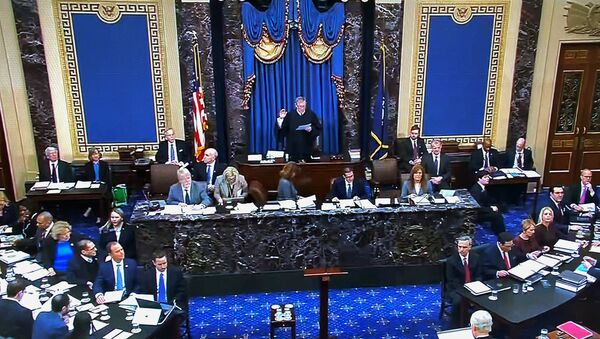A raucous debate between Democrats and Republicans over the Trump trial plan set the tone for Tuesday’s session in the Senate, which stretched into the early hours on Wednesday.
During the 12-hour-long session, the Republican-controlled Senate blocked a series of Democratic amendments to the rules resolution.
Each of the 11 measures offered by Senate Democrats, which included calls for top administration officials and additional documents to be subpoenaed, was thwarted almost entirely by the same party-line vote of 53 to 47.
Which ground rules did they agree upon?
Day 1 ended with a vote that approved the rules resolution from Senate majority leader Mitch McConnell, a proponent of a speedy trial and acquittal, with minor changes.
The resolution set the timeline of opening arguments to 24 hours spread over three days (not two, as originally suggested) for each side and delayed the question of whether the Senate should subpoena witnesses and documents until after both House Democrats and Trump’s lawyers finish making their cases and senators ask their questions.
Another change that is unlikely to satisfy the Democrats removes the provision of the draft resolution that would not have allowed the admission of the House's evidence into the Senate record without a vote. Instead, the Senate shall vote later on whether to include any documents.
Any misbehaviour?
Tensions flared throughout Tuesday’s session, with acrimony culminating in a particularly heated exchange between House impeachment manager Jerry Nadler and White House Counsel Pat Cipollone over whether Trump’s former national security adviser John Bolton should be forced to testify.
During that exchange, Nadler accused Republican senators of “voting for a cover-up” by thwarting the amendments on documents and testimony.
Chief Justice John Roberts, who holds the largely ceremonial role of presiding over the trial, sought to diffuse the tension by admonishing both House impeachment managers and Cipollone for their lack of decorum.
“It is appropriate at this point for me to admonish both the House managers and president’s counsel in equal terms to remember that they are addressing the world’s greatest deliberative body,” Roberts warned.
What will happen next?
Opening arguments will begin on Wednesday at 1 p.m. After both sides present their arguments, senators will have a 16-hour question-and-answer session, followed by a four-hour debate.
All votes on future motions in the trial will require a simple majority; the final vote on whether to convict the president needs a two-thirds majority of 67.




